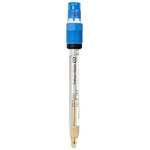The pH value is used as a unit of measurement for the acidity or alkalinity of a medium. The membrane glass of the sensor supplies an electrochemical potential depending on the pH value of the medium. This potential is generated by the selective accumulation of H+ ions on the outer layer of the membrane. As a result, an electrochemical boundary layer with an electrical potential difference forms at this point. An integrated Ag/AgCl reference system serves as the required reference electrode. The measured voltage is converted to the corresponding pH value using the Nernst equation.
Transcription de la vidéo
How potentiometric pH measurement works
At its heart potentiometric pH measurement is about detecting potential differences with special electrodes. Let’s get into it:
Glass electrodes
In traditional glass electrodes the key component is a pH sensitive glass bulb at the end of a glass tube. Inside the electrode a neutral potassium chloride solution buffered at pH 7 surrounds a silver/silver chloride wire which is the electrical connection.
A second silver/silver chloride wire in another potassium chloride solution is the reference system in an outer glass tube. A small junction separates the reference system from the solution being measured, the electrical connection but not the solution.
When the electrode is immersed in a solution the electrode detects the difference in hydrogen ion concentration across the glass membrane. This concentration difference creates a measurable potential difference which is then converted into a pH reading.
How the glass bulb works
Imagine immersing the sensor into a solution like diluted hydrochloric acid. The smaller hydrogen ions penetrate the boundary layer of the glass membrane and create a charge separation while the larger chloride ions stay outside.
Inside the bulb the hydrogen ion concentration is constant at pH 7. If the external hydrogen ion concentration is higher (acidic solutions) a potential difference is created, pH below 7. For neutral solutions the hydrogen ion concentration is the same on both sides, pH 7. For lower hydrogen ion concentration outside, pH above 7.
Non-glass sensors
For industries that can’t have glass, ISFETs are a robust alternative. They replace the traditional glass bulb with a pH sensitive layer integrated into a metal-oxide-semiconductor (MOS) transistor.
When positive hydrogen ions interact with this layer they create charge separation and the area between the source and drain becomes conductive. The current flow is directly related to the pH of the solution. Like glass sensors ISFETs also require a stable reference system protected by a junction to be accurate.
Precision for every application
The potentiometric principle as implemented by Endress+Hauser offers the highest accuracy in pH measurement. This technology serves many industries by enabling better product yields, less waste and applications where glass sensors can’t be used.
Whether glass sensors or ISFETs, potentiometric pH measurement is the foundation of liquid analysis. The science behind it and the technology around it ensures reliable results.














